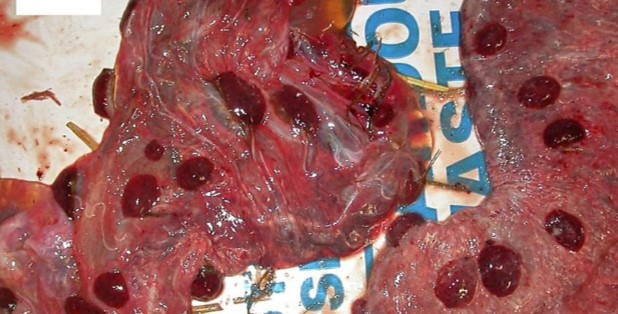Ovine chlamydiosis is a bacterial disease acquired from infected sheep or goats. It causes abortion in sheep and goats and is known as ‘enzootic abortion in ewes’ (EAE).
Chlamydophila abortus infections are the most common cause of abortions in sheep in the UK. Infected sheep and goats often have no symptoms when they first become infected, and the only sign of disease is the birth of weak or stillborn lambs in the last 2–3 weeks of pregnancy at the lambing after they were first infected. The bacteria infect the uterus and are present in the afterbirth of infected animals. So if you experience losses , 2- 3 weeks prior to your due date of lambing then always give us a call , and if you can the most useful thing to try and get hold of is a piece of the placenta from the abortion. Cut one or two of the ‘strawberries’ the lumpy parts of the placenta out with scissors, and ideally from a portion that is not filthy and put into a sealed clean plastic pot and bring in to us. We can do relatively cheaply, and quick diagnostic testing through our lab service to diagnose this disease. This is particularly important when making decisions about how to manage the rest of lambing, and those ewes that have aborted.
Humans are infected by inhaling infected material present in aerosols or dust. The risk of infection is greater indoors. Infection can also occur from contact with contaminated clothing or boots. It is not spread from person to person.
The incubation period in humans is generally 5–14 days. Infection may result in no symptoms or there may be flu-like symptoms, including headache, fever and a non-productive cough and occasionally there may be other symptoms including vomiting and sore throat. The disease is very serious in pregnant women, particularly in the second half of the pregnancy. This is one of the diseases which make it important for pregnant woman not to be involved with any lambing or ewes in late pregnancy. However I must stress that ovine chlamydiosis is very rare in humans in the UK. It is generally only seen in people who have very close contact with sheep or goats.
Head to defra website for more information if you are worried about the risks for this lambing season ahead.
http://archive.defra.gov.uk/foodfarm/farmanimal/diseases/atoz/zoonoses/lambing.htm
Get in touch to find out more about how we can help you

